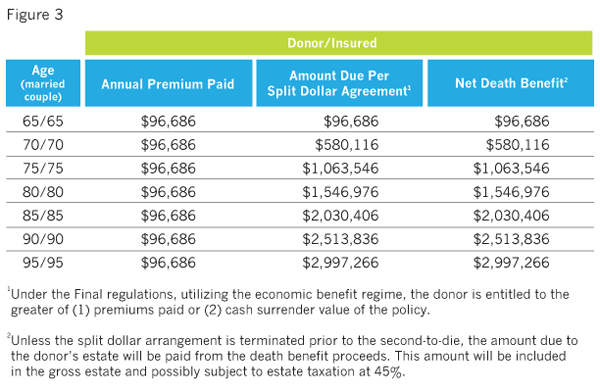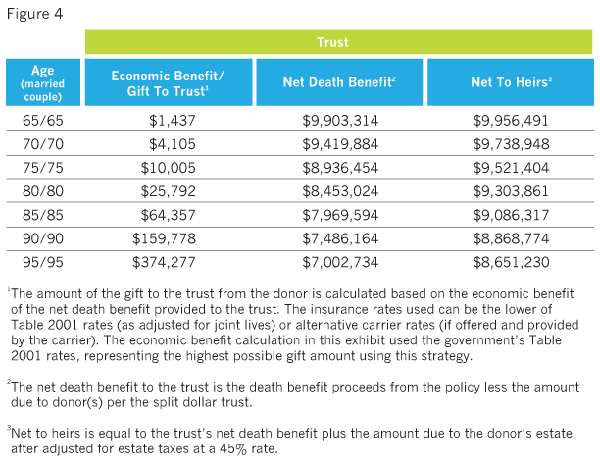Life insurance can serve as an excellent tool to leverage the aforementioned estate planning techniques. It enhances the overall wealth transfer strategy by leveraging existing assets into tax free death proceeds. This typically works to transition more wealth to the next generation(s) due to the inherent leverage life insurance provides. There is further benefit derived by having the perpetual trust own the coverage. This accomplishes similar goals of the other estate planning techniques available in that the insurance is in an estate tax/generation skipping tax free environment. Life insurance also works to anchor the other estate techniques employed. For example, if the assets do not perform as expected in a GRAT or sale strategy, the life insurance can provide an infusion of cash to bolster the trust assets.
The following is an example of a 65 year old couple who employed life insurance in their estate plan. Their estate was highly liquid, and so they did not need the insurance to create cash to help pay estate taxes. Their aim was to establish a tax free vehicle that could potentially generate a higher internal rate of return (IRR) than some of their other more conservative holdings. Figure 1 shows the IRR on cumulative premiums paid to death benefit generated on a second to die policy. It shows the second death occurring at age 85, 90, and 95. The chart also shows the IRR that would have to be achieved in a taxable investment to equal the tax free insurance return. It also models the IRR taking into account that the death benefit is free of estate tax.

The couple had limited available annual exclusion and lifetime gifting capacity. Therefore, they entered into a private split dollar agreement with the trust to mitigate exposure to potential gift taxes. Assuming the $10 million tax free death benefit is paid at age 95, the IRR is an adjusted rate of 6.72%. The equivalent pre-income tax rate of return on a taxable investment would be 8.58%. There are two important points to note about this strategy: 1) The joint mortality age of 95 is past their joint life expectancy, thus potentially improving the IRR upon an earlier death. 2) This product has a no lapse guarantee rider, which guarantees the premium and the death benefit. This rider removes the concern of policy performance relative to increased internal charges and declining crediting rates to cash value. One of the most important concerns of this strategy is to utilize the life insurance companies with the strongest financials. One way to alleviate this concern is to possibly diversify the coverage among several carriers. The financial soundness of insurance companies has never been more important than in these trying economic times.

Under the 2003 final split dollar regulations, they had the choice of executing the agreement under the ban of economic benefit regime. The loan regime assumes that each premium payment is a separate loan from the couple to the trust. The interest rate typically used is the long term applicable federal rate (AFR), which is now 3.52%. The interest each year serves as the amount the couple gifts to the trust. As the cumulative premiums increase, so does the total loan and the interest follows. Upon death or termination of the split dollar agreement, the cumulative premiums and any paid interest is returned to the couple.

The economic benefit regime is similar to a loan, except that the amount of the gift to the trust is calculated based on the economic benefit of the net death to the trust. For example, Figure 4 shows that at age 80 the gift to the trust is $25,792. The gift is calculated based on the Table 2021 rates prescribed by the IRS. If they died in this year the trust receives $8,453,024 of death benefit, while the couple receives the greater of the cash value or cumulative premiums paid which is $1,546,976. After reviewing both options, they decided to employ the economic benefit regime because it produced a lower gift to the trust for a longer period of time than the loan regime. Overall, the private split dollar method dramatically reduced their gift and produced a large sum of tax free money to the trust. To put in perspective, the cumulative gift made by age 85, equaled $374,685 with a total wealth transfer to the trust of $7,969,594. This worked well with their gifting limitation and provided the flexibility they desired.

Conclusion
The planning landscape has dramatically altered in the past decade. In the wake of the current economic turmoil, it is likely to change further, as families seek not only to provide a sustainable pool of wealth for succeeding generations, but also for the current generation as well. We have highlighted the most significant of these changes, and some of the planning advantages they present. These advantages present significant opportunities for planners, and clients, who are prepared to embrace change and navigate the altered landscape.
James R. Robinson ([email protected]) is a partner in the Private Clients, Trusts and Estates Practice Group at Schiff Hardin LLP, where he specializes in estate and gift planning, business succession planning, wealth preservation, sophisticated tax planning, charitable giving and fiduciary advising.
Stephen B. "Bo" Wilkins ([email protected]) is a partner of the life insurance advisory firm of Nease, Lagana, Eden & Culley, Inc., where he specializes in wealth transfer, business succession and charitable planning.
Footnotes:
1 Family Office Exchange, Recasting the Central Role of the Family Office as Risk Manager (2006), at v.
2 See id. at 5.
3 Robert H. Sitkoff & Max M. Schanzenbach, Jurisdictional Competition for Trust Funds: An Empirical Analysis of Perpetuities and Taxes, 115 YALE L.J. 356, 416 (2005) (hereinafter "Sitkoff").
4 See id. at 376-77.
5 See id. at 375 n.62.
6 See id. at 359.
7 See, e.g., Michele C. Marquardt, Esq., Incentive Trusts? Beware!, 33 EST. GIFTS & TR. J. 204 (2008).
8 See Jon J. Gallo, et al., An Examination of Trustees, Beneficiaries and Distributive Provisions, 42 U. MIAMI EST. PLAN. Ch. 15 (2008).
9 See, e.g., Estate of Schutt v. Commissioner, T.C. Memo. 2005-126.
10 See Sitkoff, at 381-82.
11 See, e.g., UNIF. LIMITED LIAB. CO. ACT § 503, enacted in numerous states.
12 This may not be easily accomplished. One potential means is to give an adverse party, i.e., another beneficiary, a veto power over distributions. See I.R.C. § 674.
13 DEL. CODE ANN. Tit. 30, § 1636.
14 See Richard W. Nenno, Planning with Domestic Asset-Protection Trusts, 16 ANN. REAL PROP., PROB. & TR. SYMPOSIA (Apr. 29, 2005), at 39-43 (available at www.abanet.org/rppt/meetings_cle/2005/spring/pt/AssetProctectionPlanning/NENNO_hand.pdf).
15 See DEL. CODE ANN. Tit. 12 § 3570; I.R.C. § 2038.
16 For an analogous case involving an offshore trust, see In re Stephan Jay Lawrence, 279 F.3d 1294 (11th Cir. 2002).
17 See 11 U.S.C. § 548(e).
18 See, e.g., FLA. STATS. § 222.14; N.Y. INSURANCE LAW § 3212; compare DEL. CODE ANN Tit. 18, §§ 2701, 2725 (not restricted to resident, but restricted to insurance contracts "issued for delivery" or "delivered" in-state). These statutes also offer varying degrees of protection for annuity proceeds.
19 See, e.g., GA. CODE ANN. § 33-25-11(a).
20 See, e.g., HAW. REV. STAT. § 431:10-232.
21 See, e.g., 41 U. MIAMI EST. PLAN. at ¶ 1218 (2007); Edward M. Manigault and Milford B. Hatcher Jr., GRATs and GST Planning - Potential Pitfalls and Possible Planning Opportunity 20 PROB. & PROP. NO. 6 (Nov./Dec. 2006).








